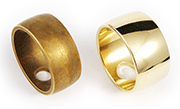E-Archive
Good Vibrations
in Vol. 15 - May Issue - Year 2014
Vibratory Finishing Operations - Stability, Reproducibility, Reliability



Vibratory finishing results
Why quality managers and dealers are excited about vibratory finishing operations!
Imagine the following situation: A prestigious and certified sheet metal plant receives an enquiry regarding the production of 5 million safety parts annually for the automotive industry, these having to be stamped and formed. As part of the calculation, the technical sales manager turns his attention to the essential aspects: Material, strength, dimensions, tolerances, feasibility. He has many years of experience and considers all possible difficulties. He utilises a sophisticated calculation program that provides him with a realistic production price down to the last cent.
Shortly before submitting an offer, he notices that the workpiece drawing includes specifications for the finish of edges and surface quality besides the data already known to him. Upon closer examination, it becomes clear that he cannot realistically estimate how this is to be treated.
He goes off to find a colleague from production planning and describes the situation to him. The colleague does not take long to reply: That's no problem! The edges can be deburred by abrasive brushing, thus making the surfaces attractive.
While returning to his office he encounters another highly experienced colleague. Out of interest, he asks the latter for his opinion. The same answer comes: "That's no problem! "We just have to stamp cleanly enough and look after our tool well". If the surface is not clean enough for our customer, we'll simply wash the parts again".
Shortly before arriving back at his office, he meets the production manager, who is interested in the new project and who wishes to give his opinion regarding a suitable method for optimizing the edges and surfaces as specified in the drawing: "We've got a shot blasting system available in the rear of Hall 4. If we use the right blasting abrasive, we can achieve a fantastic deburring result, as has already been achieved with other parts.
Somewhat irritated, the employee returns to his calculation, unsure how the requirements in the drawing are to be evaluated. After an hour, he decides to go for lunch.
In the canteen, he sits at the same table as a colleague from the quality assurance department. Because he is still preoccupied with his assignment, he starts talking about the subject. After the quality manager has described the most important key data, he asks a few questions that set the person opposite him thinking:
Are the workpieces contaminated with oil after stamping and forming?
Do the workpiece edges have to be deburred evenly and with repetitive accuracy?
Does the cleanliness of the surface play a role?
Do residues such as material abrasion and grinding dust have to be removed without leaving a trace?
Is it possible to solve all tasks in one work step?
Is it not advisable for such production volumes to find an extensive automated process that fulfils all requirements?
After several minutes reflection, the person responsible asks the quality manager: "Do you have any idea how all the tasks can be solved with one technology or do we perhaps need several work steps to manufacture quality parts conforming to the drawing?"
The quality manager smiles at him and says: "We commissioned a vibratory finishing system in our Plant 2 last year. It's solved a lot of problems since then. Above all, I now know how we can meet the requirements for edges and surfaces with process reliability!"
The two individuals delve deeper into the conversation and it becomes apparent that there are solutions that have not been speculated. The quality manager outlines the crucial advantages of the vibratory finishing operation to his colleague in just a few minutes and explains why he is happy about this technology:
Edges and surfaces are machined with a high degree of uniformity in one work step.
In the same work step, the surface is degreased, cleaned and freed of adhering residues
If workflows are well documented, vibratory finishing operations are extremely stable and reproducible
Vibratory finishing operations can be automated effectively in series processing
After a vibratory finishing operation, the products exhibit the best preconditions for all conceivable downstream processes. In particular, the high degree of cleanliness of the products forms an ideal starting point for any kind of subsequent coating.
The wide diversity of vibratory finishing operations - from simple deburring through to the mirror finishing of decorative surfaces - offer just the right solution for almost any assignment!
Satisfied, the employee returns to his office and phones the production manager in Plant 2: "We've got a new project. It involves stamping and forming 5 million safety parts for the automotive industry. I think it would be best if we then machine the parts in a vibratory finishing operation so we can comply with all quality requirements that I've found in the drawing. What do you think?"
The reaction by the production manager: "A good decision: A vibratory finishing operation makes the quality manager and even the dealers happy!"
Good Vibrations
by Dirk Gather Contributing Editor MFN and General Manager of GZO GmbH, Germany
Tel. +49.3301.5232.0
Fax +49.3301.5232.29



























